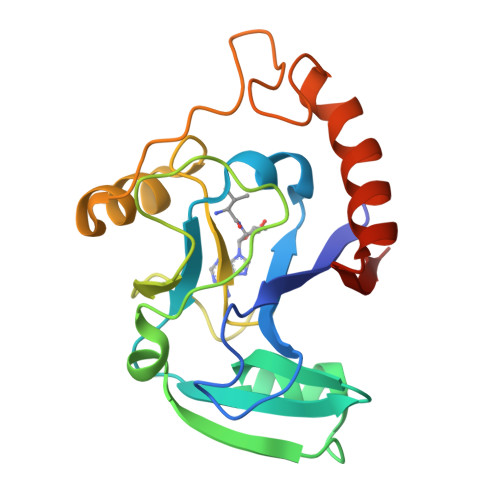Structural basis for substrate recognition by the editing domain of isoleucyl-tRNA synthetase
Fukunaga, R., Yokoyama, S.(2006) J Mol Biol 359: 901-912
- PubMed: 16697013
- DOI: https://doi.org/10.1016/j.jmb.2006.04.025
- Primary Citation of Related Structures:
1WK8, 1WNY, 1WNZ - PubMed Abstract:
In isoleucyl-tRNA synthetase (IleRS), the "editing" domain contributes to accurate aminoacylation by hydrolyzing the mis-synthesized intermediate, valyl-adenylate, in the "pre-transfer" editing mode and the incorrect final product, valyl-tRNA(Ile), in the "post-transfer" editing mode. In the present study, we determined the crystal structures of the Thermus thermophilus IleRS editing domain complexed with the substrate analogues in the pre and post-transfer modes, both at 1.7 A resolution. The active site accommodates the two analogues differently, with the valine side-chain rotated by about 120 degrees and the adenosine moiety oriented upside down. The substrate-binding pocket adjusts to the adenosine-monophosphate and adenosine moieties in the pre and post-transfer modes, respectively, by flipping the Trp227 side-chain by about 180 degrees . The substrate recognition mechanisms of IleRS are characterized by the active-site rearrangement between the two editing modes, and therefore differ from those of the homologous valyl and leucyl-tRNA synthetases from T.thermophilus, in which the post-transfer mode is predominant. Both modes of editing activities were reduced by replacements of Trp227 with Ala, Val, Leu, and His, but not by those with Phe and Tyr, indicating that the aromatic ring of Trp227 is important for the substrate recognition. In both editing modes, Thr233 and His319 recognize the substrate valine side-chain, regardless of the valine side-chain rotation, and reject the isoleucine side-chain. The T233A and H319A mutants have detectable editing activities against the cognate isoleucine.
Organizational Affiliation:
Department of Biophysics and Biochemistry, Graduate School of Science, University of Tokyo, 7-3-1 Hongo, Bunkyo-ku, Tokyo 113-0033, Japan.

















